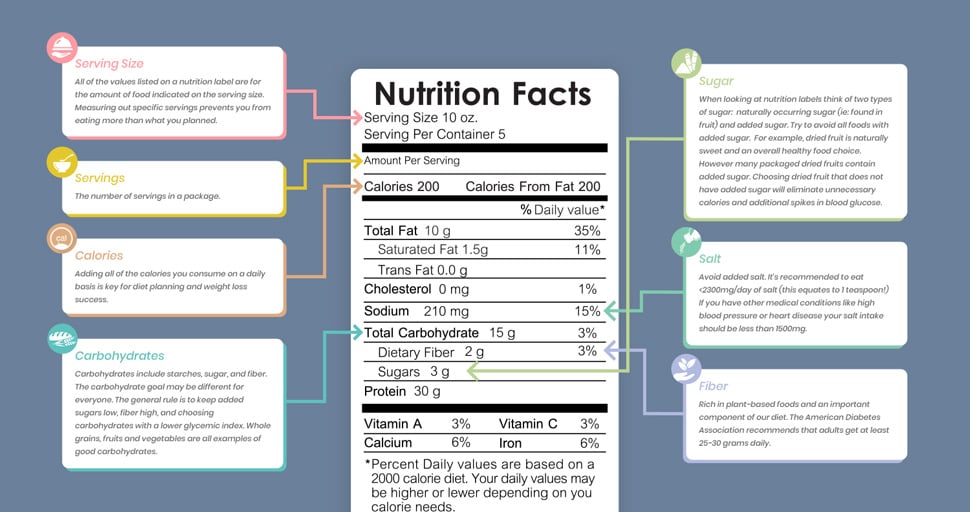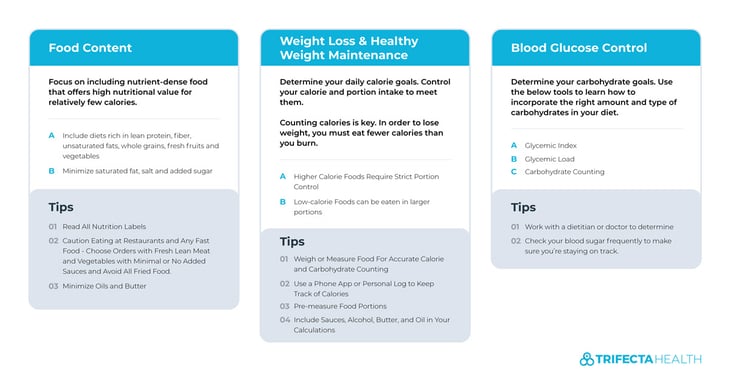Dietary modifications are arguably the most important element in treating people with type 2 diabetes and are also critical in the management of type 1 diabetes.
Diabetes meal plans should start with some general principles commonly known as the diabetic diet. This diet is designed to help people with diabetes change their eating habits to control their diabetes, so they suffer fewer consequences of the disease and hopefully are not dependent on medications for the rest of their lives.
- 3 Steps to Diabetic Diet Success
Treating diabetes starts with getting on the right diet. Here's the foundation of nutrition knowledge you need to achieve these goals.
There are some basic principles that all diabetics should follow.
- Step 1: Learn the Basic Diabetic Diet Principles
- Step 2: Use Diabetic Diet Tools
- Step 3: Personalize Your Own Diabetic Diet
Step 1: Learn Basic Diabetic Diet Principles
Start your journey by answering the three questions below. Once you know the answers to these questions, you can better guide yourself through a plan to control your diabetes. Or if you're pre-diabetic, you can prevent yourself from developing diabetes.
1. How Many Calories Should I Eat?
You need to know how many calories you should eat each day to loose and maintain a healthy weight. The cornerstone of weight loss is calories in, calories out, so you need to get on a path towards a daily calorie deficit. Step 1 is calculating your calories using our calorie calculator.
Tip: Using a phone app like the Trifecta app, or keeping a diabetic log on paper can ensure you will accurately keep track of your calories and carbohydrates. Always read nutrition labels on everything you eat!
2. How Many Carbohydrates Should I Eat?
Every diabetic needs a daily carbohydrate goal that is based on your weight, age, activity levels, and personal metabolism. This is because carbohydrates most dramatically raise blood sugar. Controlled carbohydrates lead to controlled blood sugars.
Carb Calculator
Calculate how many grams of carbohydrate you need each day using this simple carb calculator.
Let’s do this!
Your results are on their way to your inbox!
Get your results!
Enter your email address to see your results. We’ll also send you a follow-up email for your records.
This guide is a useful place to start, but these can vary based on factors specific to you, including your metabolism and what medications you're taking. So for formal recommendations, you should also discuss how many carbs you should be eating with a board-certified medical doctor or dietitian.Tip: Carbohydrate counting, glycemic index and glycemic load are tools that can help to keep track of your carbohydrates throughout the day.
3. What Food Should I Eat?
You may need to mentally prepare yourself for some changes to your eating habits. That said, there are so many diabetic food options that chances are, you'll like the taste of many of the foods you should be eating.
Learning what to look for in foods you're choosing to include and avoid in your diet is critical to your diet success.
Tip: Tools like the popular diabetes 'exchange diet' can help you learn flexible dieting that works for you.
What Diabetic Diets Should Include:
1. Lean Protein
- Helps repair tissue
- Helps build and maintain bones and muscle
- Helps create many hormones and enzymes
- Helps weight loss (helps you to feel full)
2. Healthy Fats (Aka Unsaturated Fats, Aka Monosaturated Fats)
- Increases your 'good cholesterol' (HDL)
- Lowers your 'bad cholesterol' (LDL)
- Lowers blood pressure (when they replace carbohydrates or unhealthy fats)
3. Vegetables
- Nutrient-dense: rich in vitamins, minerals, fiber, and antioxidants
- Low in calories
- High in fiber
4. Fruit
- Nutrient-dense: rich in vitamins, minerals, fiber, and antioxidants
- Low in calories
- High in fiber
- Excellent ‘sweet tooth’ substitute
5. Whole Grains
- Nutrient-dense: rich in vitamins, minerals, and fiber
- Reduce the risk of chronic health conditions including heart disease, diabetes, and some cancers.
- Reduce risk in overall mortality
6. Fiber
- Improves glycemic control
- Improves bowel health
- Recommended at least 14 grams of fiber for every 1000 calories of food you eat
What Diabetic Diets Should Avoid
Everything is balance. Eating one sweet treat isn't going to make or break your diet. But in general foods with added sugar, saturated fats, processed foods, and salt should be avoided.
1. Added sugar
- No nutritional value
- Cause high glucose spikes
- Cause weight gain
If you or a loved one is diagnosed with diabetes, eliminating added sugar should be one of the first things you tackle. This is easy to do by looking at nutritional labels under ‘added sugar’ and avoiding these foods.
2. Saturated Fats
- Cause a rise in ‘bad cholesterol’ (LDL)
- High calories
- Low nutritional value
Saturated fats increase the risk of developing and/or accentuating high cholesterol (hypercholesterolemia) as well as damaged blood vessels (atherosclerosis). All of this increases the risk of heart disease and other vascular diseases including stroke.
3. Processed Foods
- Often high glycemic index
- Often low nutritional value
- Often high calories
- Often high sodium
Not all processed foods are bad. However, they do commonly possess these undesirable properties. To ensure you're keeping your diet on point, always read nutrition labels before eating any processed foods.
4. Salt
- Increases the risk of hypertension and heart disease
A diet low in sodium (salt) (at least <2300mg/day) is recommended because it helps decrease other risk factors including high blood pressure.
If you already have high blood pressure or heart disease, your salt intake should be even lower, less than 1500 mg/day.
Step 2: Use Diabetic Diet Tools
While all of this may seem overwhelming at first, making the right choices will soon become second nature to you. There are also many tools you should utilize to help you along the way.
How to Read Nutrition Labels
There's no way to control your diet, unless you look at what the food you're eating contains. Regularly reading nutrition labels is critical for diet success.

Pitfall: Don't forget to count the sauces you eat, including salad dressings. These can frequently be high in calories, fat, and/or carbohydrates with small serving sizes.
Carbohydrate Counting
Managing diabetes necessitates you to control the number of carbohydrates you eat to maintain your goal blood glucose levels. Tools like the glycemic index, glycemic load, plate method, and exchange diet are all recommended by the American Diabetes Association to help you meet your goals.
For an in-depth explanation of what these tools are and how to best use them in your life read this article: How to Count Carbs: 7 Diabetes Tools.
To learn more about how to use the exchange diet, read this article: Food Exchange Guide for a Diabetic Menu: Food Lists & Portion Charts.
Step 3: Personalize Your Own Diabetic Diet
The best diabetic diets are tailored to meet your needs and focus on controlling calories and minimizing major fluctuations in blood glucose while providing a rich source of nutrients.
Personalized Diabetic Diet Created for You
Once you've learned these key dietary principles, you can use them to create a diet that works best for you.

Low Carb Diet for Diabetes
Low carbohydrate diets are often advocated for both diabetes and weight loss. Studies looking at this have suggested that low carbohydrate diets are more effective in treating type 2 diabetes than other diets, including calorie deficit diets alone (5,6,7,8).
While low carbohydrate diets may offer many benefits, diabetics on insulin can be at risk for hypoglycemia if they cut too many carbs without adjusting their medication. So to get all the benefits without the risk, it is important to work with your doctor when starting a low carbohydrate diet if you’re taking medications for your diabetes.
Keto Diet for Diabetics
The ketogenic diet is an ultra-low carbohydrate diet that when carefully followed over time transitions the body into utilizing a different source of fuel, called ketone bodies. For most people, this requires eating less than 20grams of net carbohydrates per day. Anyone that has attempted this would probably agree that’s really low!
While some people are strongly advocating that keto is superior, there aren’t enough well-done studies to determine if it is more effective than a basic calorie-controlled low carb (non-ketogenic) diet alone.
Want to learn more about the low carb and keto diet for diabetics? Read this article.
Diabetic Cure
While people with type 1 diabetes can live very full and healthy lives there is unfortunately not yet a known cure for this disease.
The amazing news about type 2 diabetes is that many cases can be reversed by implementing these lifestyle changes.
The best way of tackling the treatment of diabetes is to attack the disease at all ends. Integrating key lifestyle changes including diet and exercise to promote healthy weight management while taking medications as prescribed by your doctor will lead to the most success.
Stay on top of your carb intake with the free one-week low-carb meal plan. Designed to help you control calories and enjoy a nutritious, low glycemic menu.

